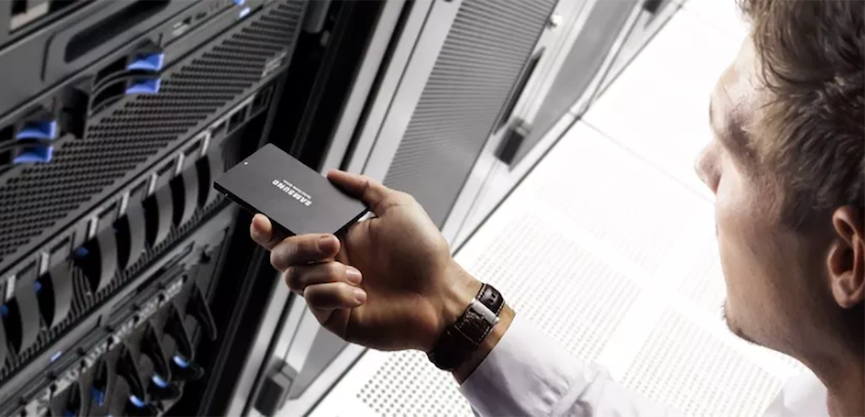In 2017, PCI-SIG announced the arrival of peripheral component interconnect express (PCIe) 4.01, but products that support this standard didn’t officially hit the shelves until last year. The technology has quickly become mainstream, with more and more people shifting to products that support this newest iteration, such as Samsung 990 PRO.
In light of this technology upgrade, you may be wondering, “What does PCIe do, and do I need to upgrade my devices to PCIe 4.0?” Because both the transfer rate and bandwidth doubled between PCIe 3.0 and PCIe 4.0, you’ll probably want to give the new standard a look, especially since we’re finally seeing PCIe 4.0 support from chip vendors.
What is PCIe?
At its most basic, PCIe is an interface that lets you connect high-speed components — such as add-on chips, memory, graphics cards and storage—to your motherboard. They are available in five different types of cards that fit into the motherboard: x1, x2, x4, x8 and x16.
These designations indicate that the cards have a corresponding number of slots that function as lanes for data to travel to and from the peripheral. One side of the lane sends data, and the other side receives it. If your PCIe interface is a PCIe 4.0 x8, that means it can handle PCIe 1.0, 2.0, 3.0 and 4.0 devices with up to eight different lanes. You’ll be able to do more with less in this case, since a PCIe 4.0 x8 slot can handle almost exactly what a PCIe 3.0 x16 slot can currently handle.
[related promo]
Another helpful aspect of PCIe devices is that they are backward and downward compatible, so a PCIe 2.0 x2 will still work with a PCIe 4.0 x8 interface. Likewise, you can put a PCIe 4.0 device into a PCIe 3.0 slot, and it will work, albeit at PCIe 3.0 speeds.
What’s the difference between PCIe 3.0 and PCIe 4.0?
The biggest change between PCIe 3.0 and PCIe 4.0 is the data transfer rate, or throughput. PCIe speed gets an upgrade in the newer iteration. PCIe 3.0’s throughput is 1GB per second per lane, providing an overall data transfer rate or bandwidth of up to 32GB/s total. PCIe 4.0 doubles the 3.0 throughput rate per lane, giving users a transfer rate of up to 64GB/s.
Why does this matter? The faster the throughput, the better performance you’ll see from peripherals such as solid state drives (SSDs). A recent PC Gamer2 story heaped the highest praise on the standard, saying, “If you want the absolute fastest drives available, then PCIe 4.0 SSDs are the way to go. They’re quicker than any PCIe 3.0 drive and will make large file transfers for such things as video editing lightning fast.”
If you’re looking to use a lot of cloud-based resources, or if you’re doing input/output-intensive work with local applications, you’ll see better performance with PCIe 4.0 than you would with a 3.0 interface.
Do I need PCIe 4.0?
SSDs that utilize a PCIe 4.0 interface will load applications and games quicker, and if your operating system is installed on one, you’ll see boot rates go up too. Samsung 980 PRO and 990 PRO SSD both feature PCIe 4.0, and the 980 PRO was the preferred storage device of MAINGEAR, which manufactures custom gaming rigs that require fast load times to support high-graphic games with as little latency as possible. Speed aside, PCIe 4.0 consumes less energy, which means devices run cooler and quieter.
In addition, PCIe 4.0 is perfect for the data-intensive workloads of today. Investing in the new standard can help you lay the groundwork for the future, as we’re really only at the beginning of 4.0 development. To start, look for devices that take full advantage of the 4.0 specifications. For example, Samsung 990 PRO has sequential read/write speeds of up to 7450/6900 MB/s, which are at the top of the maximum performance of PCIe 4.0. It also supports Microsoft DirectStorage, a technology that makes gaming and other I/O-intensive applications even speedier.
Recently, vendors have started developing and releasing drives and peripherals that take advantage of the PCIe 4.0 standard. However, with the emergence of more products that tap the new standard, the choice between the decade-old PCIe 3.0 standard and 4.0 is almost a no-brainer.
Find out whether it might be time to replace your RAID storage with an SSD. Discover how to compare MLC, TLC and V-NAND SSDs for your deployment in this free white paper.
1 PCI-SIG. “PCI-SIG Releases PCIe® 4.0, Version 1.0.” October 24, 2017.
2 PC Gamer. “Best M.2 SSDs for gaming in 2024: my top picks for blazing fast storage.” November 22, 2024.







